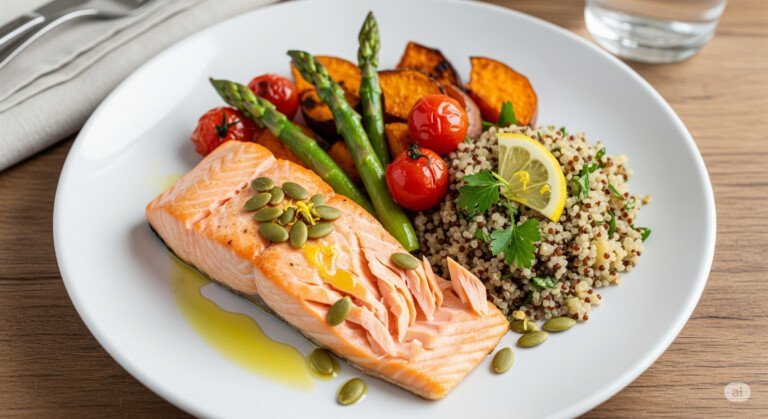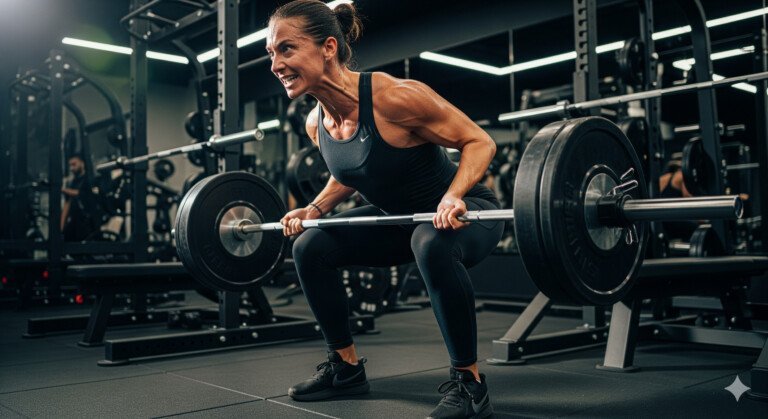Smart Portion Hacks for Easy Weight Loss
You’ve likely heard the phrase a hundred times: “You can’t out-train a bad diet.” But what if you’re eating all the right things—chicken, vegetables, and healthy fats—and still not seeing the scale move? The truth is, when it comes to weight loss, quantity matters just as much as quality. Even the healthiest foods can lead to weight gain if you eat too much of them. This is where portion control for weight loss comes in as your most powerful tool. It’s not about restricting what you can eat; it’s about learning how much you should eat to fuel your body without overdoing it.
Thank you for reading this post, don't forget to subscribe!This blog post is your complete guide to mastering the art of portion control. We’ll go beyond simply counting calories and provide you with actionable, real-world tricks that you can start using today. From simple visual guides to smart plate methods, you’ll learn how to stop guessing and start eating with intention. Get ready to transform your relationship with food and take control of your weight loss journey for good.
Why portion sizes for weight loss matter so much
The reason portion sizes for weight loss are so critical comes down to one simple concept: calories. Every food contains energy, measured in calories. When you consume more calories than your body needs, it stores the excess energy as fat. Conversely, to lose weight, you need to create a calorie deficit, meaning you burn more energy than you consume.
- The Calorie Density Trap: Many foods, especially nutrient-dense ones, can be deceptively high in calories. For example, a handful of almonds is a great source of healthy fats, but an entire bag can contain as many calories as a full meal. Without paying attention to portion sizes for weight loss, you can easily consume an extra 500-1,000 calories a day, completely negating your efforts.
- The Satiety Factor: Different foods have different satiety levels—meaning how full they make you feel. Portion control, when done correctly, helps you prioritize foods that are high in fiber and protein (like vegetables and lean meats) because they fill you up faster and keep you feeling satisfied for longer.
- A Sustainable Approach: Unlike restrictive diets that cut out entire food groups, mastering portion control allows you to eat a wide variety of foods, which is crucial for getting all the nutrients you need. It’s a sustainable, long-term strategy for maintaining a healthy weight.

The Simple Portion Plate Method
The portion plate method is a visual and highly effective way to manage your intake without the need for meticulous counting or measuring. It simplifies your meal into three easy-to-remember sections.
- Half of Your Plate: Non-Starchy Vegetables: This section should be filled with vegetables like broccoli, spinach, carrots, cauliflower, or bell peppers. They are low in calories but high in fiber, vitamins, and minerals.
- One-Quarter of Your Plate: Lean Protein: This section is for your protein source, such as chicken breast, fish, tofu, or lean beef. Protein is key for satiety and for building and maintaining muscle.
- The Last Quarter: Healthy Carbohydrates: Fill this section with complex carbs like brown rice, quinoa, whole wheat pasta, or sweet potatoes. These provide the sustained energy your body needs without the sugar crash of simple carbs.
This simple, visual method is one of the most effective portion sizes for weight loss strategies for beginners because it doesn’t require any special tools—just a plate.
Calorie Counting vs. Portion Control: Which Is Right for You?
When it comes to managing your food intake, people often ask about calorie counting vs. portion control. Both methods have their merits, and the right choice for you depends on your personality and goals.
- Calorie Counting: This method is highly precise. It involves tracking every single calorie you consume using an app or a food log. It can be a great way to learn exactly how much you’re eating and to identify hidden sources of calories. However, it can be time-consuming, tedious, and may not be sustainable for everyone in the long term. For some, it can lead to an unhealthy obsession with numbers.
- Portion Control: This method is a more intuitive approach. It focuses on general guidelines and visual cues rather than exact numbers. It teaches you how to eyeball appropriate sizes of food, which is a skill that will last a lifetime. It is less precise than calorie counting, but it is often more sustainable and less stressful for the average person.
For many people, the best approach is to start with a short period of calorie counting to learn about the calorie density of different foods, then transition to portion control for weight loss as a long-term maintenance strategy.

A Portion Guide for Beginners
If you’re new to the concept, a simple portion guide for beginners can be the key to getting started. You don’t need a food scale or measuring cups to begin—you can use your own hand as a guide.
- Palm for Protein: A serving of protein, such as chicken or fish, should be about the size and thickness of your palm. This is a simple way to get the protein you need for muscle repair and to stay full.
- Cupped Hand for Carbs: A serving of carbohydrates, like rice or pasta, should fit in your cupped hand.
- Fist for Vegetables: A serving of vegetables should be about the size of your fist. Since vegetables are low in calories and high in nutrients, you can often have more than one serving.
- Thumb for Fats: A serving of healthy fats, such as nuts or olive oil, should be about the size of your thumb. Fats are calorie-dense, so this is a crucial one to get right.
Using these simple hand guides is a fantastic way to begin mastering portion control for weight loss without any extra effort or tools.
Your Handy Portion Size Chart
To make things even clearer, here is a handy portion size chart that uses common items to help you visualize a proper serving. You can use this guide in restaurants or when preparing meals at home.
- Deck of Cards: This is roughly the size of a 3-ounce serving of protein, such as chicken, fish, or lean beef.
- Golf Ball: This is the size of a serving of nut butter or cheese.
- Tennis Ball: This is roughly one serving of fruit or a baked potato.
- Lightbulb: A half-cup serving of rice or pasta is about the size of a lightbulb.
- Dice: A single die represents about one teaspoon of oil, butter, or dressing.
- Baseball: This is the size of one serving of a low-calorie vegetable like a cup of leafy greens.
Using these visuals is one of the easiest portion control for weight loss hacks you can use in your daily life.

Putting It All Together: Healthy Portion Examples
Understanding the theory is one thing; putting it into practice is another. Here are some healthy portion examples that you can use to start building your own meals.
- Breakfast: One cup of Greek yogurt (size of a tennis ball) with a half-cup of berries (size of a lightbulb) and a handful of almonds (size of your thumb). A scoop of protein powder can be a great way to ensure you’re getting a complete and pre-portioned protein source that keeps you full all morning.
- Lunch: A large spinach salad (2 fists) with a palm-sized portion of grilled chicken, a sprinkle of cheese (size of a golf ball), and a light, oil-based dressing (1-2 thumb-sized servings).
- Dinner: A deck-of-cards-sized salmon fillet with a baked sweet potato (size of a tennis ball) and a generous side of steamed broccoli (2 fists).
These examples show you that with proper portioning, you can still enjoy delicious and satisfying meals that are full of flavor and nutrients.
The Secret Weapon: Mindful Eating and Portion Control
The final and perhaps most important piece of the puzzle is to combine the physical act of portion control with the mental skill of mindful eating and portion control.
- Eat Slowly: Your brain takes about 20 minutes to receive the signal from your stomach that you’re full. Eating slowly allows your body to register satiety, which helps you avoid overeating.
- Pay Attention: Put away your phone, turn off the TV, and focus on your food. Pay attention to the colors, textures, and flavors. When you are mindful, you are more likely to notice when you are full.
- Listen to Your Body: Mindful eating teaches you to listen to your body’s internal hunger and fullness cues. Learn to recognize when you are physically hungry and when you are just eating out of boredom, stress, or habit.
By combining the practical tips for portion control for weight loss with the mental skill of mindful eating, you create a powerful, sustainable, and enjoyable approach to food that will lead to lasting results.

Frequently Asked Questions (FAQ)
1: Will I lose weight by only practicing portion control?
Portion control for weight loss is a foundational element, but it’s not the only factor. For best results, it should be combined with a focus on nutrient-dense foods (quality) and a consistent exercise routine. However, it is the most important first step to creating the necessary calorie deficit.
2: Is a food scale necessary for portion control?
No, a food scale is not necessary. While it can be helpful for precision, you can get excellent results by using visual cues like the hand guide or the portion size chart provided in this guide. The goal is to build a skill, not to obsess over numbers.
3: Can portion control help me with my cravings?
Yes. By ensuring your portions include a good balance of protein, fiber, and healthy fats, you’ll feel full and satisfied for longer. This can significantly reduce cravings for unhealthy foods that are often high in sugar and calories.
4: How do I handle portion control when eating out at a restaurant?
When eating out, you can still use the visual cues from the portion plate method. Aim to fill half your plate with vegetables. You can also ask for a to-go box at the beginning of the meal and immediately pack up half of your entree to save for later.
5: What are some tips for portion control with snacks?
When snacking, a good habit is to put the portion you plan to eat on a small plate or in a bowl instead of eating directly from the container. This prevents you from mindlessly overeating. Also, choose snacks that are high in protein and fiber to keep you full, like a handful of nuts or some Greek yogurt.
Disclaimer:
This post may contain affiliate links. If you purchase through them, we may earn a small commission at no extra cost to you. Also, this content is for informational purposes only and does not substitute professional medical advice.











